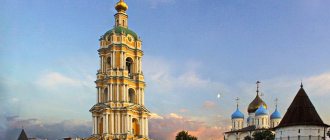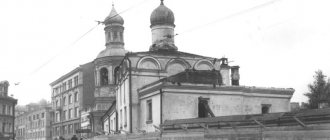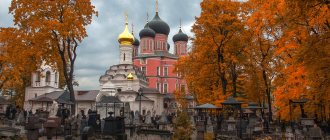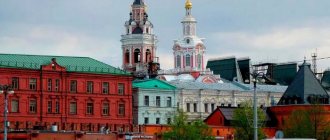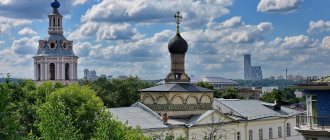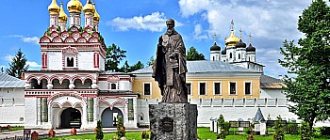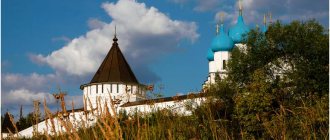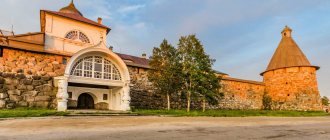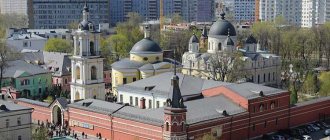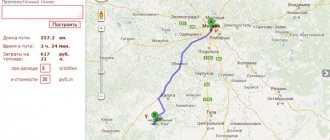"Save me, God!".
Thank you for visiting our website, before you start studying the information, please subscribe to our Orthodox community on Instagram, Lord, Save and Preserve † - https://www.instagram.com/spasi.gospodi/. The community has more than 60,000 subscribers. There are many of us like-minded people and we are growing quickly, we post prayers, sayings of saints, prayer requests, and timely post useful information about holidays and Orthodox events... Subscribe. Guardian Angel to you!
Not far from the Proletarskaya metro station is the famous and one of the oldest Orthodox sanctuaries - the Novospassky Monastery in Moscow. It was founded back in the 13th century.
Short story
At first, the sanctuary was located in the place where the Danilovsky Monastery is currently located. But over time, the cathedral was moved to the Kremlin. After large-scale construction on the territory of the Kremlin, they decided to move the monastery again. This time, by order of Ivan the Terrible, the abbey was placed on Krutitsky Hill and made into a real fortress (thanks to large defensive structures). So it began to defend the capital on the approaches from enemies along with the Danilov, Novodevichy, Donskoy and Simonov monasteries.
The walls of the fortifications and towers were built by the famous Russian master Fyodor Kon. The main current building of the Transfiguration Monastery was erected in the 1650s. A number of famous personalities are buried in the basement of this temple, including many boyars of the Zakharyin-Romanov family, bishops Porfiry and Peter of Catherine. At the beginning of the 19th century, the nun Dosithea, known as Princess Augusta Tarakanova, daughter of Catherine Petrovna, was buried in the burial vault.
At the beginning of the 20th century, with the communists coming to power, the monastery was closed. It was one of the first Orthodox institutions to suffer at the hands of the Soviet regime. The cemetery at the temple was almost immediately destroyed. On its territory, the Soviet authorities located a forced labor camp. Particularly dangerous criminals were placed in the tomb. The monastery churches turned into prison warehouses and barracks. Many shrines disappeared without a trace. And since 1935, the complex came under the control of the NKVD.
The Novospassky Monastery was returned to the monastic brethren only at the end of 1990. A major restoration of many buildings was carried out. In 2011, the monastery celebrated the 20th anniversary of the second discovery of the shrine.
Must read: Belogorsky Monastery, Perm region
History and fate of the monastery in the twentieth century
It is believed that the founder of the monastery is Prince Daniil, the son of the famous Alexander Nevsky. In 1330, the monastery was moved to Borovitsky Hill, closer to the Kremlin. This is what Prince Daniel’s successor, Ivan Kalita, already decided. In turn, John III moved the monastery to Krutitsky Hill, after which the monastery received its name Novospasskaya.
Novospassky Monastery in Moscow
- All monastery buildings were originally wooden. In 1491, the then reigning John III began the construction of a stone cathedral in honor of the Transfiguration of the Lord. Also from this moment on, the monastery becomes the ancestral tomb of the Romanovs. When Mikhail Romanov sat on the throne, several generations of his ancestors were already buried on the territory of the Novospassky Monastery. In this regard, the monastery received special attention throughout the centuries of the dynasty’s reign, and historians consider the 17th century to be the heyday of the monastery.
- from 1640 to 1642 the monastery was surrounded by a stone wall. By that time, the wooden palisade had become very dilapidated and did not adequately fulfill its function as a protective structure. The construction of the Transfiguration Cathedral was also completed. During the Patriotic War with the French invaders, the monastery was badly damaged and was burned almost to the ground. It took more than thirty years to restore it.
- Until the revolution, the Novospassky Monastery was visited by representatives of the royal family. So, in 1913, Emperor Nicholas II came here. The visit was associated with the three-hundredth anniversary of the Romanov dynasty. On this occasion, a beautiful chapel was erected in the courtyard of the monastery.
- With the arrival of the Bolsheviks, the monastery was one of the first in Moscow to be closed. A labor camp for enemies of the people and criminals was organized on the territory of the Novospassky Monastery. There was also a women's prison here. Torture and executions began to take place outside the walls of the once holy place. Today, where the convicts were deprived of their lives, an Italian courtyard has been built in memory of the tragic events of the revolutionary era.
- Some rooms began to be used as vegetable storage. Cell buildings were converted into apartments. NKVD officers kept confiscated furniture and archival documentation. Before the war, it was planned to completely demolish the monastery cemetery and dilapidated buildings. But the invasion of German troops did not allow these plans to come true.
Interior of the Novospassky Monastery in Moscow
Under Khrushchev, the buildings began to be restored. But funding turned out to be so meager that the work dragged on for two decades. After the collapse of the Soviet Union, the monastery was returned to the Russian Orthodox Church. Numerous donations began to arrive from patrons. The territory of the monastery was improved, churches were rebuilt. Divine services are held regularly and believers have the opportunity to pray at the miraculous icons, and tourists explore the architectural sights.
Description of the architecture
The main attraction of the entire monastery ensemble is, of course, the Transfiguration Cathedral, built under Tsar Mikhail Fedorovich. In size it is second only to the Assumption Cathedral. The walls were painted by a master from Kostroma, Guriy Nikitin, who was invited to the capital especially for this purpose. Many of the paintings have survived to this day.
Interesting! During the Napoleonic battles, the French tried to convert the cathedral building into stables. They wanted to lead the horses into the gallery of the Transfiguration Cathedral along the cast-iron stairs, but the animals refused to climb.
Nearby stands the Church of the Sign, which also became a burial vault for representatives of the Russian nobility. From the 18th to the 19th centuries, a necropolis was formed in the courtyard of the monastery, which included numerous burial places of aristocrats of that time. There are allegations that it was in the Novospassky Monastery that Princess Tarakanova ended her earthly journey.
Znamenskaya Church in the Novospassky Monastery in Moscow
On the territory of the monastery there are abbots' chambers, monastic cells, a refectory, the Church of the Intercession, a bell tower (78 m) and a museum.
History of the temple
In Russia, Orthodox believers had a chance to see a copy of the miraculous icon of the Mother of God, the All-Tsaritsa, the original of which is located in the Athos temple, only in 1995. The community of mercy of the holy righteous John of Kronstadt turned to the abbot of the Vatopedi monastery on Mount Athos, Archimandrite Ephraim, with a request for a copy of the miraculous icon of the All-Tsarina for the children's cancer center. This center constantly houses a large number of young patients and their parents, who should have a chance to directly turn to the image of the Mother of God for healing.
The request received a positive response and blessing that the list of the icon of the All-Tsarina be written in compliance with the church canon, prayer sessions and solemn services.
Thus, a copy of the All-Tsaritsa icon appeared in Moscow, first at the children's oncology center on Kashirskoye Highway, and later moved to the Church of All Saints on Krasnoselsky Lane, where it remains to this day. From time to time, the icon of the All-Tsarina is delivered to the children's oncology center for a service there and the opportunity for everyone to venerate the image and pray.
In 2000, a home church of the Icon of the All-Tsaritsa was created at the clinic of the P. A. Herzen Oncology Institute with the blessing of Patriarch Alexy 2. In 2011, this church was expanded and updated with the blessing of Patriarch Kirill. The church is open to a limited circle of believers: employees, patients of the clinic and institute.
Sights of Moscow openmoscow.ru
Novospassky Stavropegial Monastery Peasant Square, 10, metro station "Proletarskaya", "Peasant Zastava"
History of the monastery until 1917. Monastery in the Soviet period. Revival of the monastery. Where is it located, how to get there, visiting rules
History of the Novospassky Monastery until 1917
Novospassky traces its history back to the oldest monastery in Moscow. The monastery in the name of the All-Merciful Savior - Spassky - was founded at the end of the 13th century by the holy noble prince Daniil of Moscow, the son of Prince Alexander Nevsky. Initially, it was located at the Serpukhov outpost, on the site where the St. Daniel Monastery is now located. The son of Saint Prince Daniel, John Kalita, around 1330, moved the Spassky Monastery to the Kremlin on Borovitsky Hill near the Grand Duke's Palace. The reason for the transfer was the piety of Grand Duke John Kalita, who wished “...to establish a monastery near himself, although he would always see you on patrol...”. He wanted to see not just a monastery next to him, but a well-maintained monastery with a large number of monks and newly rebuilt premises. The Nikon Chronicle testifies to this: “And the gathering of monks was many, and they loved that monastery more than other monasteries, and they often came to it for prayer with much humility and reverence... and a lot of alms and everything needed was given to the monks living there.” The Spassky Monastery was a place of pilgrimage for the Grand Dukes and their families, which was facilitated by the proximity of the monastery to the Grand Duke's palace and the absence of a temple in the palace itself. Here, until the 15th century, the Grand Dukes buried their wives and children. Representatives of the Moscow princely family were buried in the vestibule of the Spassky Cathedral, following the example of the ancient churches of Constantinople, where rulers were buried in the vestibules “as gatekeepers of the temple.” This part of the temple retained the original structure of the tomb until the end of the 19th century. John Kalita, who took monastic vows and schema at the Spassky Monastery before his death, was buried in the newly built Archangel Cathedral of the Kremlin, which became the tomb of the Moscow princes. The cathedral church of the old Spassky Monastery - the Cathedral of the Savior on Bor - the oldest of those that existed in Moscow at the beginning of the 20th century, stood in the courtyard of the Grand Kremlin Palace, but was barbarically destroyed in 1933. In 1382, during the invasion of Khan Tokhtamysh, the Spassky Monastery was plundered and burned, and its abbot, Archimandrite Simeon, was killed. With the assistance of Grand Duke Dmitry Donskoy, the monastery was restored.
In 1490, in connection with the construction of a new sovereign court, John III decided to move the Spassky Monastery from the Kremlin to the left bank of the Moscow River, near the palace of the Sarai and Podonsky bishops (now the Krutitskoe courtyard) to the Vasilievsky camp on the banks of the Moscow River. A secluded place on the coastal hill of the Moscow River, from where the Kremlin Hill was visible, was well suited for monastic life, so here, by order of John III, the brethren of the Spassky Monastery were housed in a built wooden monastery. After the transfer, the monastery began to be called Novospassky or the Monastery of the Savior on Novy, in addition, it retained its role as a royal chamber, the primary monastery.
In 1491, Prince John III allocated funds for the construction of a stone cathedral church in the name of the Transfiguration of the Lord. The Cathedral of the Transfiguration of the Savior on the New was consecrated on September 18, 1497 by Metropolitan Simon of All Rus'. Since its foundation, the Novospassky Monastery has become the burial place of noble boyar families, mainly the Romanovs. Already in 1498, Vasily Yuryevich Zakharyin-Koshkin, a Moscow boyar, brother of Roman Yuryevich Zakharyin, who gave the name to the future ruling dynasty of the Romanovs, was buried in the tomb under the cathedral. Under Ivan the Terrible, the monastery turned into a mighty fortress. The fortress log walls with towers were strengthened, an additional fort was built, fortified with an earthen rampart, tyn and surrounded by a ditch. The monastery became one of the outposts of Moscow from the south. He had to repeatedly defend the capital from Tatar raids. So, in 1521 he took part in repelling the raid of the Tatar Khan Makhmet-Girey, in 1571 - Khan Devlet-Girey, in 1591 - Kazy-Girey. At the alarm, the archers from the guard rooms climbed stone stairs in the thickness of the walls to the loopholes. At this time, the monks lit fires and prepared boiling water in vats to then pour it on the heads of the enemy. The enemies approaching the fortress were hit from the loopholes of the lower tier, the loopholes of the second tier of the fortress walls and towers struck the enemy with targeted fire, the loopholes of the third tier conducted crossfire. At the beginning of the 17th century, the monastery withstood the siege of Polish invaders. During the Time of Troubles, the monastery was devastated because there was a road near it along which crowds of Poles and Lithuanians passed. At this time, much of what was donated by Grand Duke John III was lost. At the walls of the monastery, militia soldiers were preparing for the final liberation of Moscow from the Polish-Lithuanian invaders. “At the walls of Novospassky in 1612, on Krutitsy, Prince Pozharsky and his faithful squad kissed the cross to save Moscow and lay down their heads for it.” At the beginning of the Time of Troubles in March 1606, by order of False Dmitry I, the bodies of Mikhail and Alexander Romanov, brothers of Fyodor Nikitich Romanov, who had by that time become Patriarch Filaret, who had suffered during the persecution of Boris Godunov, were brought from remote northern and Siberian forts to Novospassky. The bodies were buried in the cathedral church. A little earlier, the ashes of Vasily Nikitich Romanov were buried here. Mikhail Fedorovich Romanov, having ascended the throne, hastened to strengthen the Novospassky Monastery, since he was not confident in the strength of his position. By his order, a new fortress wall was erected from thick oak trunks 750 meters long, and at its corners and at the entrance gates - towers with embrasures for cannons. In 1640, by decree of Tsar Mikhail Fedorovich, the wooden wall was replaced with a stone wall 7.5 meters high, two meters thick, 650 meters long, with archery, musket and cannon battles, with towers and archers. The walls were an irregular pentagon with 8 towers at the corners. The towers, in addition to military ones, performed economic functions: they housed storerooms and workshops, where monastery production related to noise or unpleasant odors was carried out (forges, production of dishes, cleaning fish), they also housed housing for the monastery servants. To build walls and towers from the Vologda Belozersky Monastery in 1642, masons and brickmakers were requested. The stone wall was built by master Fyodor Kon. The masons, summoned by Mikhail Fedorovich, settled near the monastery and formed a settlement called Kamenshchiki, from this settlement there were 2 streets leading from the Novospassky Monastery to Taganskaya Square - Bolshie and Malye Kamenshchiki streets.
In the last years of his reign, Tsar Mikhail Fedorovich Romanov began building the Transfiguration Cathedral on the site of the ancient cathedral, which was badly damaged during the Time of Troubles. The king did not have a chance to see the new cathedral, because a few months after the start of construction (July 1645) he “went to the Lord.” The cathedral church was completed after the death of Mikhail Fedorovich during the reign of his son Tsar Alexei Mikhailovich. The cathedral was consecrated on September 19, 1647 in the presence of the young king.
Even under Mikhail Fedorovich, the monastery became a nearby royal pilgrimage site. Patriarch Filaret often came here on pilgrimage, where he served memorial services for his parents and brothers.
To accommodate the Patriarch, the monastery needed a cell building, and in 1619 Patriarch Filaret “granted one hundred rubles to the house of the all-merciful Savior for the cell structure.” At the expense of the patriarch, a one-story building of cells was built in the monastery, which also housed a bathhouse, bakery, kitchen and other premises. At the same time, the patriarch tripled the tented bell tower on the territory of the monastery and in it a temple in the name of St. Savva the Sanctified, since on the day of St. Savva the Sanctified, December 5, 1618, the future patriarch was freed from Polish captivity.
The abbots of the monastery at different times were the future patriarchs of All Rus': Job (the first patriarch of All Rus'), Pitirim, Nikon. Archimandrite Job of the Simonov Monastery was abbot of the Novospassky Monastery from 1575 to 1581. In 1581, he attended a council convened by Tsar Ivan the Terrible on the issue of adopting the Code of Law. In 1586 he was appointed archbishop in Rostov, and on January 26, 1589 he was elevated to the rank of first Patriarch of All Rus'. Patriarch Job founded the Donskoy Monastery. Job was a supporter of Boris Godunov and supported him in enthroning him. In 1605 he was expelled by False Dmitry I and exiled to the city of Staritsa. Under Vasily Shuisky, he was summoned to Moscow for nationwide church repentance in the Assumption Cathedral. Patriarch Job died in exile in 1607. By order of Tsar Alexei Mikhailovich, his remains were transferred to Moscow and buried in the Assumption Cathedral of the Kremlin. Patriarch Job was canonized by the Russian Orthodox Church. Monk Nikon, a stern ascetic, who had ten years of parish priesthood, the death of three children, taking tonsure, three years of hermitage on Solovki and seven years of monasticism in a distant northern monastery, was transferred to the Novospassky monastery from the Kozheozersk hermitage. After Nikon was appointed archimandrite of the Novospassky Monastery, his ascent to the heights of power began, which resulted in church reform, a split in the church and the emergence of the Old Believers. In 1649, Nikon became Metropolitan of Novgorod, and after that he was elevated to the rank of All-Russian Patriarch. In 1667, the Church Council deposed Nikon, and after that he was sent into exile to the Ferapontov Monastery, and then to the Kirillo-Belozersky Monastery. For a long time, the Novospassky Monastery was associated with the personality of Nikon, recalling that his ascent to power began here. Nikon took a direct part in the construction of the Transfiguration Cathedral of the Novospassky Monastery.
In 1646, Athonite monks who were stationed in Novospasskoye told Nikon about the appearance in the city of Khlynov (the modern city of Vyatka) of the miraculous image of the Savior Not Made by Hands. On Nikon’s initiative, the image was requested to Moscow, and so its main shrine appeared in the monastery. On January 14, 1647, at the Yauz Gate, Alexei Mikhailovich and Patriarch Joseph met the icon. The Tsar personally brought the icon into the Kremlin, and before the consecration of the Novospassky Monastery Cathedral, the miraculous image was in the Assumption Cathedral of the Kremlin. In 1670, the icon of the Savior was released with the regiment of Prince Yu. A. Dolgorukov against Stepan Razin, and after the successful completion of the campaign, in gratitude for the victory, the icon was decorated with a silver-gilded chasuble, with diamonds, yachts and large pearls. Unfortunately, during Soviet times, the image, which was the main shrine of the Novospassky Monastery, was lost.
In 1654, when the plague was raging, killing 2/3 of the population of Moscow, the royal treasury was transferred to the Novospassky Monastery. At the end of the 17th century, Novospassky was one of the richest monasteries in Moscow and one of the largest patrimonies. Behind him in the “ruzhnaya register” of 1681 there were 14 thousand serfs. Estates, fishing grounds, lands with villages, forests and meadows were assigned to the monastery. By 1677, the brethren of the monastery reached the number of 138 people. Tsar Fyodor Alekseevich considered it his sacred duty to visit the monastery every week to worship his ancestors, especially after his beloved aunt Irina Mikhailovna was buried here. Princess Sophia and Tsars Peter and John visited Novospassky. At the same time, the Novospassky Monastery became a place of imprisonment for criminals and heretics. There were dungeons and gates built here. Here in 1618, the Monk Dionysius, the rector of the Trinity-Sergius Lavra, was sent here for the unauthorized exclusion of the word “fire” from the missal in the prayer during the consecration of the Epiphany water, for which he was recognized as a heretic. In the Novospassky Monastery he was starved and smoked. He was subsequently canonized. Rebel archers who had been tortured in the Preobrazhensky and Detective orders were sent here for detention until sentencing. Some teachers of the Moscow Theological Academy were sent here to serve their sentences for their adherence to the teachings of Sylvester Medvedev, a supporter of Sofia Alekseevna, executed in 1691.
Peter I, as a sign of respect for the tomb of his ancestors, ordered the casting of a bell weighing 1,100 pounds, nicknamed the bell of Peter the Great, for the monastery. With the transfer of the capital from Moscow to St. Petersburg, the Novospassky Monastery gradually began to decline, as significant contributions to the monastery ceased.
During the reign of Empress Anna Ioanovna, military invalids were sent to the monastery to support them. In the 17th century, Novospassky was often visited by Empress Elizaveta Petrovna. It was under her that the modern monastery bell tower was founded. In 1750, ponds were dug from the northwestern side of the monastery: a large rectangular pond and a small square pond, and the old pond with an island in the middle was renewed. The ponds were connected to each other and to the Moscow River by underground pipes. There was a monastery bathhouse nearby. Roach and crucian carp were found in abundance in the ponds. Nowadays, only one rectangular Novospassky pond has survived from the system of ponds, from which a picturesque view of the monastery opens.
In 1812, the monastery suffered severe destruction.
The French plundered the monastery sacristy, devastated and burned cells and other buildings. Historian I.M. Snegirev wrote: “On the very day the enemy entered Moscow, in the evening, the first Poles appeared to rob a defenseless monastery; the next day, September 3, the French came there and, having sent out the Poles, began to continue looting the cells and churches. The governor, wanting to appease them, offered them a treat of bread and salt; but the predatory enemies were not content with this, they demanded money from him, beat him and brought him beaten with a novice to the cathedral. There, putting them on their knees in the middle of the temple and placing guns on their chests, they ordered them to confess to each other, as if before death; then, threatening to shoot, they asked where the monastery treasures were hidden; at the same time, they inflicted several wounds on the elder with sabers, without forcing him to confess either by threats or wounds, and released him barely alive... Meanwhile, amid the robbery, rioting and outrage of the enemies, on the same day in the evening from the forest row that caught fire at the monastery on the north side and from flammable substances thrown by the French, the monastery itself was engulfed in flames... At night, the bell tower also caught fire, where the thousand-pound bell of Peter the Great, which fell with a terrible crash, broke through and collapsed the vaults of the St. Sergius Church on the second tier and hung on the ruins of the first; after him, a 425-pound semi-tree fell from the fourth tier and broke a large bell into small pieces. This shook the entire huge bell tower building; the iron ties in him were broken; but its walls and top were not damaged. The abbot's chambers with the Church of the Intercession were turned by the enemies into barracks, and Znamenskaya - into a stable. Having robbed the churches of everything that could be captured, (the enemies), in the hope of finding treasures, dug up graves in the monastery cemetery, broke open stone tombs in the tomb under the cathedral, and even thrones and altars in the altars. The enemies attempted to complete the destruction of the holy monastery by blowing up the cathedral, where, according to eyewitnesses, they dug holes for gunpowder; but we didn’t have time to do that.” It was the rector of Novospassky, Archimandrite Ambrose (Ornatsky), who in 1813 was entrusted with the restoration of some Moscow monasteries that suffered from the atrocities of Napoleon’s army. For “special diligence and care” he was presented with the Order of St. Anne of the second degree. By 1820, all the buildings of the monastery that had suffered from the atrocities of the French were repaired. A new two-story building of cells was built along the western part of the fortress wall. In the 30-40s of the 19th century, the monastery churches were renovated. On November 2, 1817, Emperor Alexander I visited the Novospassky Monastery. On April 13, 1900, the Novospassky Monastery and the tomb of the Romanovs were visited by the Sovereign Emperor Nicholas II and his wife, Empress Alexandra Fedorovna. From 1906 to 1909 The rector of the Novospassky Monastery was Archbishop Boris (Shipulin). Under his leadership, all the buildings of the monastery were restored, the Brotherhood building was expanded, and steam-water heating was installed in the Intercession Cathedral, painting was resumed and crosses on the domes were gilded. He organized non-liturgical conversations with the people. Under his leadership, a series of brochures, “The Well-Wisher Leaf,” was published describing the history and sights of the Novospassky Monastery. Under Soviet rule, he was sent into exile in Tashkent. In a fabricated case, he was accused of leading the Central Asian “counter-revolutionary organization of churchmen” and was shot in 1938. From 1909 to 1914 The abbot of the monastery was Bishop Macarius (Gnevushev). He said that “the time the Orthodox Church is going through is one of the most difficult in the history of Christianity,” and believed that “as long as the church exerts its saving influence on the people, the revolutionaries are powerless to win them over to their side, because the Church supports in “He has love and devotion to the Fatherland and the Throne.” Under him, the Brotherhood of Church Singing and Temperance was organized in the Novospassky Monastery, which included more than 300 people. Thanks to Bishop Macarius, in conditions of a general cooling towards the faith, Sunday conversations with parishioners attracted up to 700 people. Separate missionary classes were held for men, women and children, readings for soldiers, and education for the illiterate. Bishop Macarius was accused of creating a counter-revolutionary organization with the aim of overthrowing Soviet power. The reason for his accusation was the ringing of bells, allegedly calling for an uprising. He was sent to Smolensk, where he was shot in 1918. Vicar of the monastery in 1920-1921. there was Archbishop Pavlin (Kroshechkin). He was arrested three times and served his sentence in exile and camps. On charges of anti-Soviet activities, he was imprisoned in the Novo-Ivanovo branch of the NKVD Siblag, where he continued his service, although in those years 10 years of strict regime were added for a blessing. Every morning he served a prayer service for which religious prisoners and believers gathered. He said: “The bullying and persecution of believers by the Soviet authorities only strengthens our faith in God, and therefore we must tirelessly support the spirit of religion not only in ourselves, but also in other people.” Archbishop Pavlin was shot on November 3, 1937. The last abbot of the Novospassky Monastery before its closure (1921-1924) was Archimandrite (later bishop) Evgeniy (Kobranov). Shot in 1937. Novospassky Monastery in the Soviet period On September 10, 1918, the housing and maintenance department of the Rogozhsko-Simonovsky district issued an order according to which the brethren were asked to vacate the premises of the monastery within three days.
The monks were only allowed to take clothes with them, as well as everything related to the religious cult. “Furniture of all types,” said the decree, “remains in place, such as: beds, mattresses, pillows, blankets, tables, chairs, as well as kitchen utensils. Failure to voluntarily comply with this order will result in violent action.” In November 1918, the Extraordinary Commission of the Rogozhsko-Simonovsky District organized a forced labor camp here for women who did not please the new authorities. One of these prisoners was the daughter of Lev Nikolaevich Tolstoy, Alexandra Lvovna Tolstaya. From her memories, a terrible picture emerges of the destruction of the monastery cemetery, the destruction of graves, and the desecration of churches. She told how prisoners tore open graves at night in search of jewelry in order to get a vacation to the city for a successful find. During the first years of Soviet power, the monastery housed a women's prison, then - one of the first forced labor camps in Moscow for criminals and political prisoners (ITL). Of the five churches, four were closed. The Church of the Mother of God of the Sign has been turned into a prison barracks. The camp’s sanitary doctor reported: “The Novospassky ITL is in a terrible state, some of the crypts of the graves are accessible to the curious, the coffins have been opened and parts of the skeletons are open. Some cellars, and especially the basement under the monastery, are dirty and are a real cesspool.” During these terrible years, mass executions took place in the monastery. Some of the people doomed to death were brought, supposedly for sanitation, to the Znamensky Church and here they were shot. The corpses were buried near the monastery walls in an embankment on the side of the Moscow River. The monastic community existed until 1926 as a brotherhood in the name of the All-Merciful Savior at the Church of St. Nicholas, which had a separate entrance from the street. The miraculous icon of the Savior Not Made by Hands, the main shrine of the monastery, was moved there. After the temple was closed in 1926, the image disappeared without a trace. When 300 parishioners applied for the transfer of other churches to them, they were refused “due to the inconvenience of such combination for the Soviet institutions located in the former monastery.” The Soviet institutions were the Administration of Prisons and the Main Archive of the NKVD. Formally, after nationalization, the Novospassky Monastery was transferred to the department of the All-Russian Collegium for Museums and the Protection of Monuments of Art and Antiquities of the Main Science of the People's Commissariat of Education, although gradually the temples and premises of the monastery were occupied by the Main Directorate of Prisons GUMZAK and adapted to their needs. Thus, a theater club was organized in the cathedral, where prisoners staged blasphemous plays. Until 1922, the monastic values were not protected by anyone. In accordance with the Decree on the confiscation of church valuables in 1922, 4 pounds of gold items, 38 pounds of 37 pounds of gold and silver, 135 precious stones, a pearl chasuble weighing 2 pounds with 1,582 diamonds were confiscated from the Novospassky Monastery. The phelonion from the sacristy of the Novospassky Monastery is kept in the Kremlin Armory. 20 of the most valuable books are in the Historical Museum. The fate of most of the valuables and shrines is unknown. By decision of the Moscow Soviet in September 1927, the cemetery of the Novospassky Monastery was completely destroyed.
After the Great Patriotic War, the premises of the monastery were occupied by residents and various institutions. The Sheremetev tomb was equipped as a dormitory, and then as a sobering-up center. All the premises of the monastery, including the watchtowers, were occupied for housing. Subsequently, the premises were transferred to various institutions, and a furniture factory was located at the Konyushenny Dvor. After the Great Patriotic War, the archive of the Tagansk prison was housed in the Spassky Cathedral. On the territory there is a coal and timber warehouse, a monumental sculpture factory, a furniture factory with a boiler room. Revival of the Novospassky Monastery On March 28, 1968, the Council of Ministers of the RSFRS adopted a resolution according to which “taking into account the outstanding historical, cultural and artistic significance of the ensemble of architectural monuments of the Novospassky Monastery in the city of Moscow and, in connection with this, the importance of its museum display to the population and tourists, to organize in the Transfiguration Cathedral with its unique artistic value of interiors and buildings, a museum of the history and modern practice of restoration in the USSR.”
In 1968, restoration work began in Novospassky. Temples and monastery premises were occupied by the Soyuzrestavratsia association, the All-Russian Research Institute of Restoration and their workshops. In 1991, the monastery was transferred to the Russian Orthodox Church. Here, with the blessing of Patriarch Alexy of Moscow and All Rus', the Stavropegial Monastery was revived. Patriarch Alexy II of Moscow and All Rus' became the rector and Holy Archimandrite of the revived monastery, and Archimandrite Alexy Frolov became his first vicar, then Bishop Orekhovo-Zuevsky, vicar of the Moscow diocese. Since 1972, the monastery buildings have been recognized as architectural monuments and taken under state protection. On March 23, 1991, services in the monastery were resumed: the Divine Liturgy was served in the Transfiguration Cathedral. On September 17, 1995, the remains of the Moscow Governor-General, uncle of Nicholas II, Grand Duke Sergei Alexandrovich, who was brutally murdered by the terrorist Kalyaev in 1905, were solemnly transferred from the Kremlin to the Novospassky Monastery in front of a large crowd of people. The burial of the Grand Duke was discovered near the building of the former Supreme Council on Ivanovo Square in the Kremlin. For a long time this place was used as a parking lot for government vehicles. A cross-monument to the Grand Duke was erected there, made according to Vasnetsov’s sketches by the sculptor N. Orlov and the author of the project D. Grishin. This cross was destroyed in 1918 personally by Lenin's decree. Recreated in 1998 with the blessing of Patriarch Alexy II. The initiator of the transfer of the remains to the Novospassky Monastery was the Orthodox society "Radonezh".
Today the monastery carries out great spiritual and educational work.
There is a Sunday school at the Novospassky Monastery and a singing school for boys. The men's choir of the Novospassky Monastery is among the best monastic choirs in Moscow and conducts active concert activities. The brethren provide spiritual care to the Herzen Oncological Institute and Psychoneurological Boarding School No. 18. The monastery publishes a youth magazine “Heir”. The Orthodox youth association “Young Rus'” operates within the walls of the monastery. The Novospassky Monastery houses especially revered Orthodox shrines. Icon of the Mother of God “Hodegetria” of Smolensk XV-XVI centuries. - contribution of nun Martha, mother of Tsar Mikhail Fedorovich. Located in the iconostasis of the Transfiguration Church. The Icon of the Mother of God “The All-Tsarina” is an exact copy of the miraculous image kept in the Vatopedi monastery. Delivered as a gift to the monastery in 1997 from Holy Mount Athos. Located in the gallery of the Transfiguration Church. Icon of the Savior, Not Made by Hands (19th century) - a copy of the miraculous icon that was previously in the monastery. Novospassky Stavropegial Monastery Where is it located (address) 115172, Moscow, Krestyanskaya Square, 10, Nearest metro stations, metro station "Proletarskaya", metro station "Krestyanskaya Zastava" How to get there or walk from the nearest metro stations You can walk to the Novospassky Monastery in 5- 8 minutes from the Proletarskaya or Krestyanskaya Zastava metro stations, walk towards the Novospassky Bridge. What you can’t do. It is forbidden to wear shorts, short skirts, or bare shoulders in the monastery.
Women cannot enter the monastery without a hat and trousers. For those who come in trousers, skirts will be provided at the entrance. When open Open to the public during morning and evening services. At the end of the evening service, the monastery is closed to visitors How to call Sources: Snegirev I. M. “Novospassky Monastery”, M., 1843 I. D. Dmitriev “Moscow Novospassky Stavropegic Monastery in its Past and Present” M., Novospassky Monastery, 2005 “Novospassky Monastery” Album M., Novospassky Monastery, 2009 “Forty Forty” Compiled by P. G. Palamarchuk. Volume 1 M., Astrel AST 2004 “Taganka 70 years” Article by V. I. Rumyantsev “Novospassky Monastery” Publishing house “Virtus-Poligraph”, 2006 Pilgrimage to the holy places of Orthodox Moscow
All male and female monasteries in Moscow >>> Pokrovsky Convent >>> Vysoko-Petrovsky Monastery >>> St. John the Baptist Convent >>> Novodevichy Convent >>> Spaso-Andronikov Monastery >>>
Where to go in Moscow in weekend
Kolomenskoye >>> Sokol village >>> Poklonnaya Gora >>>
What interesting things to see in Moscow
All Moscow monuments >>> Narkomfin House >>> Rogozhsky Old Believer village >>>
Moscow museums
All Moscow museums >>> Apartment museum F. M. Dostoevsky >>> S. A. Yesenin Museum >>>
Where to eat inexpensively
Inexpensive cafes and restaurants in Moscow >>> Other attractions of Moscow >>>
Patronal holidays
The main church patronal holiday - the Transfiguration of the Savior, is celebrated on August 19 according to the Gregorian calendar. The Orthodox Church honors it as one of the twelve holidays. August 31 – festive (praise) great service in veneration of the icon of the Mother of God, the Blessed Virgin Mary “The All-Tsaritsa” (Pantanassa). October 14 – Celebration of the Holy Protection of the Intercessor of our Mother of God. On the same day, a service is held in honor of the divine composer of prayers and psalms, Roman the Sweet Singer, the beloved heavenly patron of the Romanov dynasty. December 10 – festive service in veneration of the icon of the Mother of God “The Sign”. This is the main temple holiday of the Church of the Sign.
The Lord said that it is not the healthy, but the sick who need a doctor. Rarely does anyone come to the Novospassky Stauropegic Monastery out of idle curiosity. In Moscow there are many holy places of prayer where the soul is cleansed from sorrow and filled with grace.
People bring their illnesses, sorrows, a heavy burden of guilt and resentment here. And anyone who comes with sincere faith and a need for help will certainly receive it - in the form of relief, strengthening of mental strength, and often physical healing.
Article design: Vladimir the Great
Current state
Now the monastery is fully operational and open to visitors from morning to evening. Monks live according to strict rules. Pilgrims and just tourists can come here.
Attention! Guests must adhere to the general rules when staying on the territory of the monastery. Clothes should be closed and modest. It is not allowed to photograph the abbot, brethren or the interior of churches. Not all buildings are open to the public.
The monastery courtyard is not very large. He is carefully looked after. In the warm season there are a lot of flowers and greenery, fruit trees and vineyards grow all around.
Activities of the parish
The monastery helps the oncology clinic and conducts classes at the Alcohol and Drug Addiction Rehabilitation Center. There is a Sunday school and a teaching and learning center here. The Novospassky Monastery became the headquarters for the Young Rus' youth movement. The monastery runs a publication that publishes the Orthodox magazine for young people “Heir” and the “Orthodox Youth Newspaper” for teenage children.
Shrines
The relics of the Great Martyr Demetrius of Thessalonica rest in the monastery. The Ark was transported from Greece in 2015. The event was timed to coincide with the seventieth anniversary of the victory over the Nazis.
Reliquary with the relics of the Holy Great Martyr Demetrius of Thessalonica
Here is a copy of the icon of the Mother of God “The All-Tsarina”, the original of which is kept in the Vatopedi Monastery on Athos, and a copy of the icon of the Miraculous Image of the Savior, made from a miraculous icon of the 19th century.
The shrine of St. John of Kronstadt also belongs to the shrines of the monastery.
Patronal holidays
Particularly revered holidays in the Novospassky Monastery include the Transfiguration of the Lord - August 19 and the Intercession of the Holy Virgin - October 14.
In addition, the following dates are celebrated:
celebration of the day of the icon of the Mother of God “The Sign” (December 10); celebration of the day of the icon of the Mother of God “Vsetsaritsa” (August 31); Day of Remembrance of Prince Sergei Alexandrovich, brother of Tsar Nicholas II, killed by a terrorist in 1905; days of memory of the holy royal passion-bearers (16- July 17); Memorial Day of the Venerable Martyr Grand Duchess Elizabeth Feodorovna (July 18); Memorial Day of Bishop Macarius of Oryol, who was rector of the monastery in 1909-1914. (September 4); Memorial Day of the Hieromartyr Peacock (November 3); celebration of the Icon of the Mother of God of Smolensk (August 10).
Directions to the monastery
You can get to the Novospassky Monastery by metro to the Proletarskaya or Krestyanskaya Zastava stations. Then walk about 800 m.
You can also take buses and trams to the Dinamovskaya Street stop:
The Krutitsky Monastery is very well located on the banks of the Moscow River. While visiting it, you can stroll along Moscow embankments, looking at the city landscapes.
Mini-tour of the Novospassky Monastery:
Schedule of services
Today, services are held in three churches of the monastery. Every day they host:
Midnight Office at 7:00. Liturgy at 8:00. Morning and evening services.
On holidays and Sundays, the liturgy is held at 9:00. These days a huge number of parishioners and pilgrims come to the cathedral.
Must read: Church of the All-Merciful Savior in Mitino, schedule of services
It is worth noting that entry into the community is prohibited in short skirts, shorts, or clothing with open shoulders. A woman must have a headdress.
How to get to the holy Orthodox monastery
One of the most convenient options is to take the metro. Get off at Proletarskaya station and walk along 3rd Krutitsky Lane in the direction of Novospasskoye Highway. The high bell tower of the cathedral can be seen from afar.
The exact address of the Novospassky Monastery is Russia, Moscow, Krestyanskaya Square, 10.
Here you can order a prayer service, a prayer service with an akathist, a note for the liturgy, conduct unction, magpie, and a memorial service. Also on the territory of the complex there is a training and methodological center, a Sunday school, a rehabilitation center, a publication, a library, and an Orthodox youth magazine.
May the Lord protect you!
You will also be interested in watching a video about the Novospasskaya monastery:
Icon "The Queen of All"
This is the greatest shrine of Athos, a copy of the miraculous image (the original is located on Mount Athos in the monastery). Donated to the holy monastery in 1997.
Many people come to the monastery to touch this icon. She helps and heals those who suffer. And it has long been noticed that cancer patients receive special help from “The Tsaritsa.”
Many people suffering from alcoholism, smoking and drug addiction receive hope for healing and are cured.
Within the walls of the monastery you can purchase oil consecrated after the prayer service for anointing the sick, as well as a prayer with an image of the icon.
History of the All-Tsaritsa icon
The main icon of the Mother of God, called the All-Tsarina, or Pantanassa, has been in Greece in the Vatopedi monastery since the 17th century. Located in the cathedral church to the left of the royal gate.
The icon is small in size. It depicts the Blessed Virgin Mary with a baby in her arms. The Mother of God sits on a throne, behind which are located on both sides two angels, reverently overshadowing the Most Pure Virgin with their wings. Baby Jesus is in the arms of the Mother of God, holding a scroll in his left hand, and sending a blessing with his right hand.
According to church traditions, the first miracle from the icon of the All-Tsarina happened in ancient times. The young man, who has no faith and is engaged in witchcraft and magic, which is recognized by the church as a sin, decided to perform a witchcraft ritual in front of the icon of the Mother of God, which was not destined to happen. During his muttering, the face of the Virgin Mary lit up with a bright radiance. This light was filled with unusual power and threw the sinner very far from the icon. The young man was frightened and decided to repent of his actions before the servants of this temple and become a monk in order to serve at the church on Athos.
This event was perceived as a miracle from the holy image, which led the lost soul to repentance and faith. The wonderful events from the All-Tsaritsa icon do not end there. People turning to the image of the Virgin Mary for help in this temple began to testify to miraculous healing from an illness in the form of a malignant and benign tumor.
Cancer is not a new disease of modern times, but a problem that people faced back in the 17th century, but there was no medical treatment as such. The sick turned with prayer to the Mother of God, who was considered the only salvation. Those who prayed sincerely and with all their soul received healing, as evidenced by the entries in the church books of the monastery in Vatopedi on Athos.
Numerous copies of the icon began to be made and sent around the world, so that more people with cancer or their relatives would have hope for healing by turning to the image of the All-Tsarina.
Having appeared in Russia, the icon of the Mother of God to the All-Tsaritsa also showed a miracle. The improvement of children's health in the oncology center in Moscow began to be diagnosed more often with the appearance of the icon, because doctors themselves noted this phenomenon, explaining that drugs cannot provide such a result.
Confirmation that the icon is miraculous is the fact that the image began to flow myrrh on the day of the Nativity of the Blessed Virgin Mary. The temple was filled with fragrance from a few drops. It was again noticed that the icon streams myrrh on the day of the Entry of the Most Holy Theotokos into the temple. Such signs strengthened the spirit of believers and those praying for recovery from cancer and other ailments.
The first liberation of a young man from illness, or more precisely, from drug addiction, is the beginning of miraculous help from the icon of the All-Tsarina in Russia. The good news was passed around Moscow from mouth to mouth and there were more and more people wanting to touch the shrine and pray for their misfortune. It was decided to move the icon to the Church of All Saints and periodically deliver it back to the children's center for worship and spiritual assistance to the sick and their families.
The history of writing copies of the icon of the Mother of God the Tsaritsa for Moscow does not end here. In 1997, the miraculous image of the Mother of God appeared in the Novospassky Monastery. The icon has the same property of streaming myrrh and helping the desperate, those praying with a special sense of faith, to be healed or receive relief from illness.
In the Moscow region there is another list of the All-Tsaritsa - located in the city of Serpukhov in the Vladychny convent. It is recorded that this image streamed myrrh 30 times, which is a real miracle.
Official website of the Novospassky Monastery
https://novospassky-monastery.rf/
Address
Moscow, Krestyanskaya square, 10
The Novospasskaya monastery is historically connected with the Romanov dynasty; the founder of the family, Vasily Zakharyin, is buried within the monastery. The father of the first tsar from the Romanov family, Mikhail Fedorovich, was the governor of the Savior on Novy, later the All-Russian Patriarch, Filaret. The monastery graveyard became the last refuge of numerous Romanov relatives. This explains the special attention of Russian tsars and emperors to the family shrine. The period of the reign of the Romanov dynasty can be considered the heyday of the monastery. Vast lands and waters were assigned to it, rich donations were made, new temples were built and old ones were renovated.
The Napoleonic invasion turned into fire and ruin. During the retreat, the French wanted to blow up the churches, but it didn’t work. It took only 8 years to completely restore the walls and buildings and re-consecrate them.
Until the October Revolution, the monastery occupied an important place in the Russian church hierarchy, was a model of monasticism, and a center of spiritual enlightenment. The persecution of the church by the new government was felt with particular force in Moscow. The actions of the Bolsheviks in relation to the capital's churches and monasteries cannot be called anything other than a pogrom. The newly-minted rulers tried with all their might to get rid of the “ideological enemy.” Already in 1918, the monastery cells accommodated not monks, but prisoners; not divine services, but torture and executions were held here. The entire territory went to the NKVD department. The war that had just begun prevented the implementation of the Bolshevik plan to completely destroy the monastery. They wanted to blow it up following the example of the Cathedral of Christ the Savior.
During the Khrushchev “thaw”, through the zeal of caring people such as the artist Korin, restoration work began in the monastery and restoration workshops were opened. But true revival came only with the collapse of the USSR. However, the “dashing” nineties were not an easy time. Archimandrite Frolov and the Moscow Patriarchate had difficulty defending the rights of the church to the premises of the monastery. Too many commercial structures wanted to acquire real estate in this place.
Today, the Novospassky Monastery has established a monastic charter and services are held. Thousands of Muscovites come here to offer their prayers within the walls of this ancient Russian shrine.
Transfiguration Cathedral
This is the main monastery church. The first stone building was built only 20 years later than the Assumption Cathedral of the Kremlin, in 1494. Before the construction of the Cathedral of Christ the Savior, it was the second largest church building in Moscow. Wars, unrest, and fires affected the strength of the walls, and during the reign of Mikhail Fedorovich the cathedral was rebuilt. The temple was consecrated in 1649, since then it has remained virtually unchanged.
When looking at the church, the influence of the Byzantine and Pskov schools is immediately noticeable. This is typical for all temples of that time. In plan, the building is a quadrangular (four-pillar, according to the church canon) structure, crowned with 5 domes. On the outside, each side is decorated with 3 apses (half-vaults). The interior walls and vaults are painted with amazingly beautiful frescoes of Old Russian writing. Many frescoes were included in the collection of the Tretyakov Gallery, some have been lost, but what remains makes an indelible impression.
Church of the Intercession of the Blessed Virgin Mary
It adjoins the Transfiguration Cathedral from the west and has a common porch with it. The church was built in just two years, from 1673 to 1675, by the will of Tsar Alexei Mikhailovich and at his expense. There are three chapels in the temple: the main altar - in the name of the Virgin Mary; the right side chapel is dedicated to St. Demetrius, and his relics are also located here; the left side chapel is to the Great Martyr Barbara. After the occupation of Moscow by the French in 1812, it was illuminated anew. Another consecration took place in 1997, after the return of the church to the Russian Orthodox Church. The ritual was timed to coincide with the Feast of the Intercession of the Blessed Virgin Mary.
Temple of the Icon of the Mother of God “The Sign”
It was built 200 years after the Transfiguration Cathedral, adjacent to it from the north-west. The temple was erected by the first of the Romanov tsars, Mikhail Fedorovich, in honor of a family heirloom - the icon of the Mother of God of the Sign. Many of the king's relatives are buried in the chapel of the church. By the end of the 18th century, the building had become very dilapidated. The construction of a new temple on the site of the previous building was carried out on the initiative and with the financing of Count Nikolai Petrovich Sheremetev. The consecration of the church took place in 1795.
Church of St. Nicholas the Wonderworker
Money for the construction of the monastery churches was allocated not only by the Romanov family, but also by the highest nobility. So, Prince Y.K. Cherkassky paid for the construction of a temple in honor of St. Nicholas. This happened in 1652; the northwestern part of the monastery courtyard was chosen as the location. Throughout its history, the temple served as a monastery hospital. At first, the small temple was rebuilt and expanded several times. An interesting fact is that this is the last of the monastery buildings where services were held under the Bolsheviks. The building is currently under reconstruction.
Temple of St. Roman the Sweet Singer
The “youngest” church of the monastery, it was erected in 1902. The venerable saint lived in the 6th century in Constantinople, he became famous for composing prayers and hymns, including a kontakion for the Nativity of Christ. The Romanov family revered the saint as their heavenly patron. The temple is located in the basement of the Transfiguration Cathedral, next to the Romanov tomb. It has now been completely restored.
Tomb of the Romanovs (museum of the history of the Novospassky Monastery)
Since ancient times, the boyars of the Zakharyin-Yuryev-Romanov family were buried within the walls of the Transfiguration Cathedral of the Novospasskaya monastery. Inside the foundation of the Cathedral of the Transfiguration, 70 representatives of the glorious dynasty are buried in the family crypt. It must be said that the first destroyers of the crypt were not the Bolsheviks at all, but the French in 1812. The last person to be buried in the tomb was Sergei Aleksandrovich Romanov, the Moscow governor who was killed by revolutionaries in 1905; his ashes were transferred here in 1995.
The destruction of the Romanov crypt was finally completed by the Bolsheviks, after which little was left. Now a museum has been created on the site of the crypt. There are not many exhibits here - only about a hundred. They tell about the history of the monastery, but are mainly related to the life and death of Grand Duke Sergei Alexandrovich.
